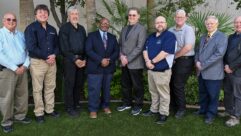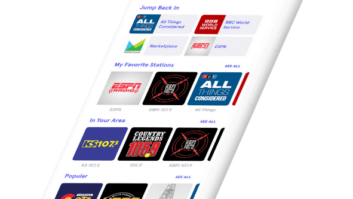
Paul Brenner, left, of Emmis and NextRadio talks with Bob Struble of iBiquity Digital at CES. Emmis, Intel and iBiquity worked on the original app at the behest of NAB Labs.
Credit: Photo by Leslie Stimson “My number one goal for 2014 is to get broadcasters to put more content into the app” — to invest in the NextRadio application beyond its free logo so more listeners can experience its interactive features.
So says Emmis Communications Senior Vice President/Chief Technology Officer Paul Brenner, president of the Emmis-backed NextRadio app business. He says user data show that consumer adoption can increase if more stations support interactive features.
The app provides local over-the-air reception on smartphones with enabled FM chips; the headset or speaker wire serves as the receive antenna. It adds interactive features, when stations support them, such as song purchase, song rating, social media coupons and geo-location services, all using the phone’s data channel.
Sprint has pledged to embed and activate FM analog tuners in about 30 million devices over three years. In exchange, the radio industry pledged $15 million worth of on-air ad inventory in each of the three years. Sprint also gets 30 percent of revenue from ads on the app, as we’ve reported.
The carrier told RW that as of early February, 11 models were available at retail that either come pre-loaded with, or can support, the NextRadio app.
Those are Samsung’s Galaxy Note 3, Galaxy S4 Mini and Galaxy Mega; LG’s G2 and G Flex; HTC’s Desire (VMU), One, One Max and EVO 4G LTE; and the Motorola G and ZTE Max, both from Boost Mobile, a division of Sprint.
CONSISTENCY
Automakers and Sprint also want more stations to support the interactive features; they want the display and user experience to be as consistent as possible with those of digital audio offerings like Pandora, iTunes and other platforms.
Some 3,064 stations, up from 2,700 in the fall, are represented visually in NextRadio through the TagStation content service.
Of that figure, about 2,750 are using the basic, free level of integration; they uploaded logos to display default artwork in the app. The rest, around 300 stations owned by 22 radio groups, have paid to use TagStation to deliver album art and other interactive elements. Emmis owns 18 of those stations.
Some of these groups are delivering full data capability on all of their FMs, others are starting with some stations and plan to add interactivity to all of their stations over time, as we’ve reported.
The setup fee is $400 per station; then a monthly $35 fee covers album art, content management and TagStation serving content out to the NextRadio application. Emmis prefers to bills the latter annually at $420.
New since last fall are Bryan Broadcasting Corp., One Connection Media Group and Schurz Communications Inc.
Other groups supporting advanced capabilities, in addition to Emmis, are Beasley Broadcast Group, Bonneville, Bott Radio Network, Carter Broadcast Group, CBS Radio, Cox Media, Cromwell Group, Entercom, Greater Media, Hall Communications Inc., Hubbard Radio, Lincoln Financial Media, Radio One, Radio Training Network Inc., Rome Radio Partners, Univision, Wilks Broadcast Group and YMF Media LLC.
While that list includes notable big groups, some of the largest radio companies, including Clear Channel and Cumulus, have yet to participate beyond free logos.
Hubbard Radio President/CEO Bruce Reese told RW that the app “makes us look like the other digital” offerings, like Pandora or other customized streamed content. Also, the interactivity “gives us a digital backchannel.”
SLINGSHOT
To make it easier for stations to offer interactivity, Emmis has developed a software app called Slingshot, for those that want to use it. The broadcaster says it will make TagStation, which drives data to the NextRadio app, easier for stations to use; Slingshot is “middleware” that connects a station’s automation system to TagStation.
Emmis has partnered with automation and middleware providers to make sure playout systems at stations can be used to deliver data through TagStation to NextRadio. Partners so far include TRE, PADapult, Center Stage Live, Jumpgate and Wide Orbit Automation for Radio.

Slingshot connects a station’s automation system to TagStation. Where supported systems are not in place, Emmis said it’s working with stations to make sure additional purchases aren’t necessary to get started by providing the specialized middleware link. Emmis says Slingshot works with current playout systems and is included, if needed, with a TagStation license.
IN THE CAR
Emmis is still in discussions with wireless carriers beyond Sprint about embedding and activating FM chips in cellphones. The broadcaster also sees the “connected car” as a possible growth area, so it has developed a prototype auto companion app, aided by funding from NAB Labs. A driver could thus experience the enhanced FM experience by NextRadio, either via smartphone or directly with an infotainment system.
Whereas a smartphone user who wants to listen to FM via NextRadio might have to pause another audio app and plug in the earbud antenna, a driver using NextRadio via the car would face no such obstacles.
“We’re just going to add on this experience that lets them interact with the local station they’re tuned to,” Brenner said. “We’re enhancing learned behavior as opposed to changing learned behavior.”
The prototype integrates HD Radio technology and IP-delivered services using the Ford Applink and OpenXC, the open development environment for app integration with a vehicle.
Using the auto app, the listener would hear audio through the FM analog or HD Radio car stereo. Paired with a smartphone, the app can deliver synchronized visuals to the car audio system; the driver controls the interactive elements using the steering wheel buttons. The app acts as a backchannel and sends commands back to TagStation.
Another possibility, according to Brenner: “All visuals are in the car, using embedded NextRadio, with either the car’s integrated cellular modem sending commands back to TagStation or through the paired phone (using the customer’s own data plan) back to TagStation.”
In short, a driver could listen to the radio without having to program anything, and could interact with the radio using the steering wheel buttons, while also getting NextRadio’s interactive benefits. “You’re not having to reach for the phone or look at that screen,” said Brenner. Other automakers, including GM, Honda and Toyota, have approached Emmis about the concept.
The auto app concept helps automakers with the issue of driver distraction caused by more advanced visual systems, according to Brenner.
Brenner’s aim is to help connect the driver to the device while controlling the car and not having to look at a phone all the time. “I think that’s what 2014 is — the connected car gives way to the connected driver.” NextRadio fits well into what carmakers are trying to achieve, according to Brenner.
Should automakers and NextRadio go further with the auto companion app development, each automaker would need to approve a version of the app for their connectivity system, like Ford Sync or Toyota Entune. Each automaker would then provide that app in its own app store. “They would ship a car with our app in the dash,” said Brenner, who adds there remains a lot of work to be done on this front.












